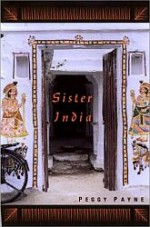
Any story starring a 400-lb protagonist, set amid the ancient mystery and exotic seduction of an Indian holy city, and involving a culture-shocked group of American tourists ought to be at least semi-capable of holding the reader’s interest.
Sister India, by Peggy Payne, isn’t and doesn’t.
On the contrary, the reading experience is surprisingly bland. Granted, the choice of narrative voice is intriguing; unquestionably, the descriptions of sunrise over the Ganges are enticing; certainly, the diversity of characters lend the piece some modicum of personality, but overall, the story seems lifeless, uninterested in its audience, fetid: much like Madam Natraja herself.
“…I have more flesh than Ganesha, the elephant-faced god,” She tells the reader on the second page, “Yet I’m told that once on my feet, I move like an Indian, sinuous and flowing. I’ve darkened some from the sun, but my hair is still ashy-blond, long and straggly, with threads of grey, and my eyes are light brown to the point of gold. Having these eyes, this huge body, helps me: people keep their distance. In a place just next to the Ganges, close to the pyres of burning bodies, newcomers especially are careful of anything that might unsettle them more.”
The travellers who arrive at her hotel, referred by a guidebook recommendation, are invariably dismayed to find that this ill-tempered, sari-wrapped “one-woman blend of East and West” is their hostess, and this season, their shock has scarcely subsided when a series of outbreaks of violence between Muslims and Hindus brings the city to a standstill.
Jill the advertising rep., T.J. the southern beaurocrat, Marie the retiree, and the other guests at Madame Natraja’s Saraswati Guest House are less than pleased to discover that they are, for all practical purposes, prisoners in the hotel. They can go out into the streets, Natraja explains, and the police will take no notice of them since they are not Indian, but there will be nothing to buy, no method of travel but foot, and no passage out of the city until the government-imposed curfew is lifted. And, she adds, lurking beneath their ostensible impunity as foreigners is the chance that they will get caught in the midst of more violence.
The result of this enforced togetherness is, naturally, a raging epidemic of cabin fever, and one by one the guests venture out into the deserted streets. Disregarding Natraja’s warnings, they take advantage of their opportunity to explore the city without the masses of humanity that normally fill it wall-to-wall, and when the curfew is unexpectedly lifted for a few hours one day, they naively believe that the danger is over.
They could not be more wrong.
“Something seemed amiss. [Marie] reached for her bag and cane, spotting Dilip across the way. But there were people still arriving: here was a man coming up the path by himself. … He stopped short of her bench, watching from under the canopy of trees as more people emerged.
“The temple was certainly emptying. She should go.
“The man near her held a white package tucked under his arm—a box of sweets, no doubt, that he’d brought for an offering. She could see the red print on the lid; it looked exactly like the sweet boxes Natraja left piled in the trash.
“Yet she could not stop the sudden thought: bomb. He has come here to leave that bomb. … Getting to her feet, she noticed how her heart was beating. …
“There on a bench, twenty feet away, was the white box with the red print.
“A young girl had perched on the other end—barefoot, braids dark against the red of her little salwar shirt.
“’Get away,’ Marie shouted, motioning with her free arm. ‘Run!’”
While Sister India contains mildly suspenseful moments and vaguely interesting character concepts, Payne’s background as a travel writer is painfully obvious, and her agenda detracts time and again from the reader’s enjoyment of the story.
In essence, this is a travel book with a plot, woven just tightly enough to provide structure for guidebook-style commentary on the holy city of Varanasi, India.







